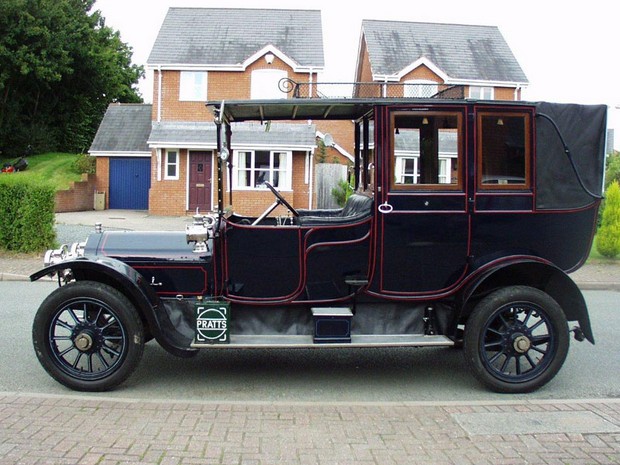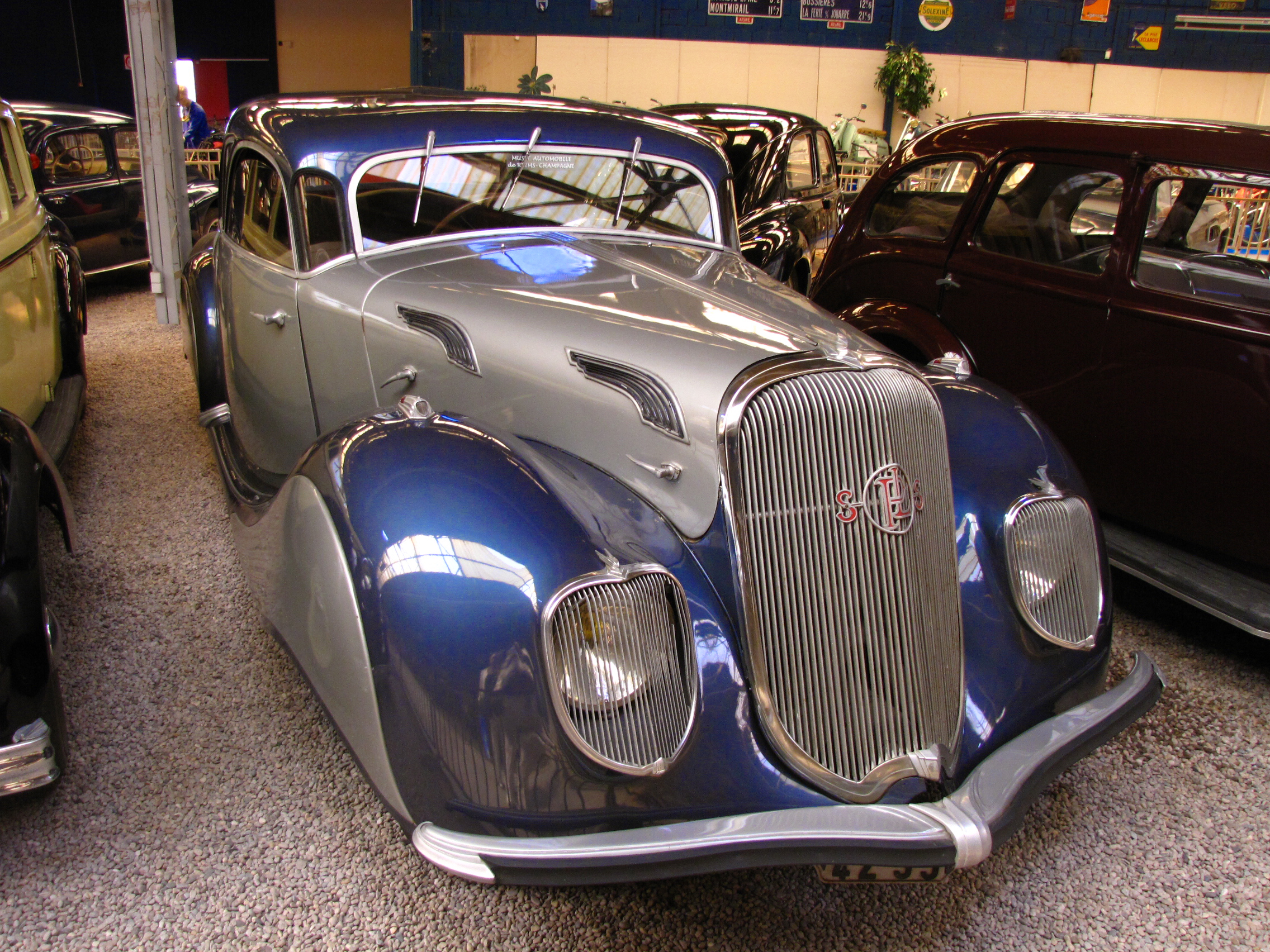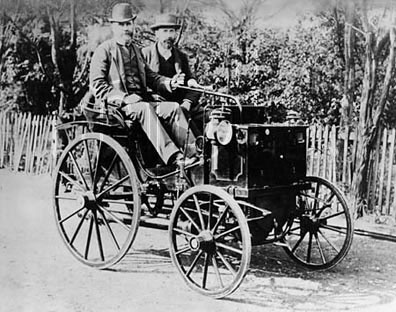|
Panhard CS
The Panhard CS is a luxury car, most commonly sold with a four-door sedan/saloon body, introduced by Panhard & Levassor at the end of 1929 for the 1930 model year. It was presented as a smaller companion model to the 8-cylinder model. Publicity of the time indicated the "S" in the name stood for "surbaissées" (the cars having an "underslung" chassis.With an "underslung" chassis, the axles were placed directly above (rather than beneath) the chassis “floor”, so that the car's height and centre of gravity could be lowered.) The car was launched with a 6-cylinder in-line Sleeve valve The sleeve valve is a type of valve mechanism for piston engines, distinct from the usual poppet valve. Sleeve valve engines saw use in a number of pre-World War II luxury cars and in the United States in the Willys-Knight car and light truck. ... engine of 2,344 cc, placing it in the 13CV car tax band. The factory bodied "CS Type X68" four door sedan/saloon/berline offered seating for ... [...More Info...] [...Related Items...] OR: [Wikipedia] [Google] [Baidu] |
Panhard & Levassor
Panhard was a French motor vehicle manufacturer that began as one of the first makers of automobiles. It was a manufacturer of light tactical and military vehicles. Its final incarnation, now owned by Renault Trucks Defense, was formed by the acquisition of Panhard by Auverland in 2005, and then by Renault in 2012. In 2018 Renault Trucks Defense, ACMAT and Panhard combined under a single brand, Arquus. History Panhard was originally called Panhard et Levassor, and was established as an automobile manufacturing concern by René Panhard and Émile Levassor in 1887. Early years Panhard et Levassor sold their first automobile in 1890, based on a Daimler engine license. Levassor obtained his licence from Paris lawyer Edouard Sarazin, a friend and representative of Gottlieb Daimler's interests in France. Following Sarazin's 1887 death, Daimler commissioned Sarazin's widow Louise to carry on her late husband's agency. The Panhard et Levassor license was finalised by Louise, w ... [...More Info...] [...Related Items...] OR: [Wikipedia] [Google] [Baidu] |
Paris
Paris () is the capital and most populous city of France, with an estimated population of 2,165,423 residents in 2019 in an area of more than 105 km² (41 sq mi), making it the 30th most densely populated city in the world in 2020. Since the 17th century, Paris has been one of the world's major centres of finance, diplomacy, commerce, fashion, gastronomy, and science. For its leading role in the arts and sciences, as well as its very early system of street lighting, in the 19th century it became known as "the City of Light". Like London, prior to the Second World War, it was also sometimes called the capital of the world. The City of Paris is the centre of the Île-de-France region, or Paris Region, with an estimated population of 12,262,544 in 2019, or about 19% of the population of France, making the region France's primate city. The Paris Region had a GDP of €739 billion ($743 billion) in 2019, which is the highest in Europe. According to the Economist Intelli ... [...More Info...] [...Related Items...] OR: [Wikipedia] [Google] [Baidu] |
FR Layout
In automotive design, a FR, or front-engine, rear-wheel-drive layout is one where the Internal combustion engine, engine is Front-engine design, located at the front of the vehicle and rear-wheel-drive, driven wheels are located at the rear via a drive shaft. This was the traditional automobile layout for most of the 20th century. Modern designs commonly use the front-engine, front-wheel-drive layout (FF). It is also used in high-floor Bus, buses and School bus, school buses. Front mid-engine, rear-wheel-drive layout In automotive design, a front mid-engine, rear-wheel-drive layout (FMR) is one that places the internal combustion engine, engine in the front, with the rear wheels of vehicle being driven. In contrast to the front-engine, rear-wheel-drive layout (FR), the engine is pushed back far enough that its center of mass is to the rear of the front axle. This aids in weight distribution and reduces the moment of inertia, improving the vehicle's car handling, handling. The me ... [...More Info...] [...Related Items...] OR: [Wikipedia] [Google] [Baidu] |
Sleeve Valve
The sleeve valve is a type of valve mechanism for piston engines, distinct from the usual poppet valve. Sleeve valve engines saw use in a number of pre-World War II luxury cars and in the United States in the Willys-Knight car and light truck. They subsequently fell from use due to advances in poppet-valve technology, including sodium cooling, and the Knight system double sleeve engine's tendency to burn a lot of lubricating oil or to seize due to lack of it. The Scottish Argyll company used its own, much simpler and more efficient, single sleeve system (Burt-McCollum) in its cars, a system which, after extensive development, saw substantial use in British aircraft engines of the 1940s, such as the Napier Sabre, Bristol Hercules, Centaurus, and the promising but never mass-produced Rolls-Royce Crecy, only to be supplanted by the jet engines. Description A sleeve valve takes the form of one or more machined sleeves. It fits between the piston and the cylinder wall in the cylin ... [...More Info...] [...Related Items...] OR: [Wikipedia] [Google] [Baidu] |
Tax Horsepower
The tax horsepower or taxable horsepower was an early system by which taxation rates for automobiles were reckoned in some European countries such as Britain, Belgium, Germany, France and Italy; some US states like Illinois charged license plate purchase and renewal fees for passenger automobiles based on taxable horsepower. The tax horsepower rating was computed not from actual engine power but by a mathematical formula based on cylinder dimensions. At the beginning of the twentieth century, tax power was reasonably close to real power; as the internal combustion engine developed, real power became larger than nominal taxable power by a factor of ten or more. Britain The so-called RAC horsepower rating was devised in 1910 by the RAC at the invitation of the British government. The formula is: : \frac where: : D is the diameter (or bore) of the cylinder in inches, : n is the number of cylinders The formula was calculated from total piston surface area (i.e., "bore" only). The fac ... [...More Info...] [...Related Items...] OR: [Wikipedia] [Google] [Baidu] |
Paris Motor Show
The Paris Motor Show (french: Mondial de l'Automobile) is a biennial auto show in Paris. Held during October, it is one of the most important auto shows, often with many new production automobile and concept car debuts. The show presently takes place in Paris expo Porte de Versailles. The ''Mondial'' is scheduled by the ''Organisation Internationale des Constructeurs d'Automobiles'', which considers it a major international auto show. In 2016, the Paris Motor Show welcomed 1,253,513 visitors, making it the most visited auto show in the world, ahead of Tokyo and Frankfurt. The key figures of the show are: of exhibition, 8 pavilions, 260 brands from 18 countries, 65 world premieres, more than 10 000 test drives for electric and hybrid cars, more than 10 000 journalists from 103 countries. Until 1986, it was called the ''Salon de l'Automobile''; it took the name ''Mondial de l'Automobile'' in 1988 and ''Mondial Paris Motor Show'' in 2018. The show was held annually until 1976; ... [...More Info...] [...Related Items...] OR: [Wikipedia] [Google] [Baidu] |
Panhard Et Levassor Dynamic
The Panhard et Levassor Dynamic is a large car introduced by the French auto-maker Panhard et Levassor as a replacement for the company’s CS model at the Paris Motor Show in October 1936. The bodies For the Dynamic, Panhard et Levassor’s in-house designer Louis Bionier came up with a Streamline Moderne design, featuring front and rear wheel spats, two or three windscreen wipers and the split A pillars with curved glass inserts he pioneered on the earlier Panoramique. The headlights were integrated into the front wings, with headlamp surrounds that mimicked the shape of the front grille. Several of these features caught on with other auto-makers in subsequent years; headlamps integrated into the bodywork became mainstream, but in 1936 they gave the car a very modern look. The bodies were also of great technical interest. Despite its size, the Dynamic offered little comfort to traditional coachbuilders, being the first French car in the luxury class to feature a steel ... [...More Info...] [...Related Items...] OR: [Wikipedia] [Google] [Baidu] |
Panhard Vehicles
Panhard was a French motor vehicle manufacturer that began as one of the first makers of automobiles. It was a manufacturer of light tactical and military vehicles. Its final incarnation, now owned by Renault Trucks Defense, was formed by the acquisition of Panhard by Auverland in 2005, and then by Renault in 2012. In 2018 Renault Trucks Defense, ACMAT and Panhard combined under a single brand, Arquus. History Panhard was originally called Panhard et Levassor, and was established as an automobile manufacturing concern by René Panhard and Émile Levassor in 1887. Early years Panhard et Levassor sold their first automobile in 1890, based on a Daimler engine license. Levassor obtained his licence from Paris lawyer Edouard Sarazin, a friend and representative of Gottlieb Daimler's interests in France. Following Sarazin's 1887 death, Daimler commissioned Sarazin's widow Louise to carry on her late husband's agency. The Panhard et Levassor license was finalised by Louise, w ... [...More Info...] [...Related Items...] OR: [Wikipedia] [Google] [Baidu] |
Rear-wheel-drive Vehicles
Rear-wheel drive (RWD) is a form of engine and transmission layout used in motor vehicles, in which the engine drives the rear wheels only. Until the late 20th century, rear-wheel drive was the most common configuration for cars. Most rear-wheel drive vehicles feature a longitudinally-mounted engine at the front of the car. Layout The most common layout for a rear-wheel drive car is with the engine and transmission at the front of the car, mounted longitudinally. Other layouts of rear-wheel drive cars include front-mid engine, rear-mid engine, and rear-engine. Some manufacturers, such as Alfa Romeo, Lancia, Porsche (944, 924, 928) and Chevrolet (C5, C6, and C7 Corvettes), place the engine at the front of the car and the transmission at the rear of the car, in order to provide a more balanced weight distribution. This configuration is often referred to as a transaxle since the transmission and axle are one unit. History 1890s to 1960s Many of the cars built in the 19t ... [...More Info...] [...Related Items...] OR: [Wikipedia] [Google] [Baidu] |
1930s Cars
Year 193 ( CXCIII) was a common year starting on Monday (link will display the full calendar) of the Julian calendar. At the time, it was known as the Year of the Consulship of Sosius and Ericius (or, less frequently, year 946 ''Ab urbe condita''). The denomination 193 for this year has been used since the early medieval period, when the Anno Domini calendar era became the prevalent method in Europe for naming years. Events By place Roman Empire * January 1 – Year of the Five Emperors: The Roman Senate chooses Publius Helvius Pertinax, against his will, to succeed the late Commodus as Emperor. Pertinax is forced to reorganize the handling of finances, which were wrecked under Commodus, to reestablish discipline in the Roman army, and to suspend the food programs established by Trajan, provoking the ire of the Praetorian Guard. * March 28 – Pertinax is assassinated by members of the Praetorian Guard, who storm the imperial palace. The Empire is auctioned off ... [...More Info...] [...Related Items...] OR: [Wikipedia] [Google] [Baidu] |




.jpg)



